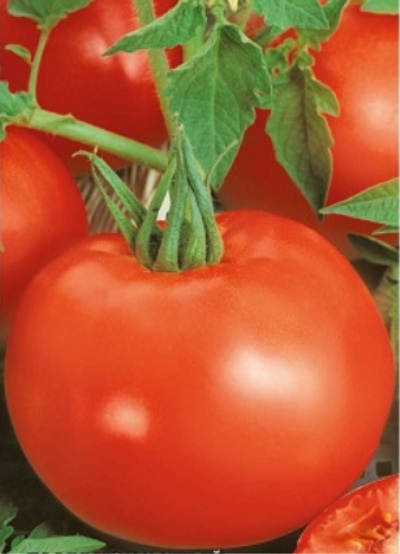
- Authors: S. F. Gavrish, V. V. Morev, E. V. Amcheslavskaya, O. A. Volok, (LLC Agrofirma "Gavrish")
- Year of approval: 2007
- Category: hybrid
- Growth type: indeterminate
- Appointment: fresh consumption
- Ripening period: mid-season
- Ripening time, days: 119
- Growing conditions: for plastic greenhouses, for greenhouses
- Bush size: tall
- Leaves: dark green, large
The hybrid tomato variety Ural was created by domestic breeders specifically for growing in the region of the same name. However, it can be successfully cultivated throughout the Russian territory.
Breeding history
Tomato Ural is a hybrid of the first generation. The development of the nightshade culture was carried out by a whole group of scientists consisting of well-known specialists S.F. Gavrish, E.V. Amcheslavskaya, V.V. Morev, O.A. The originator was LLC Agrofirma "Gavrish" together with the Research Institute of Selection of Vegetable Crops. In the state register in the Russian Federation, the tomato has been listed since 2007, it is recommended for growing in glazed and film greenhouses.
Description of the variety
The Ural tomato is an indeterminate tall plant. The leaves on it are large, dark green. There are simple inflorescences, no branching. There are 3-4 fruits in the brush, which are firmly attached to the trunk. During the growing season, 7-10 brushes develop on the bush, on each of which berries of approximately the same size are formed, which ripen at the same time.
There are quite a few advantages to culture:
- immunity to a large number of diseases;
- excellent keeping quality and transportability of fruits;
- high yields;
- uniform ripening.
The main qualities of the fruit
The fruits of the Urals are of a standard flat-round shape, the surface is glossy, ribbed in the upper part. The green berries that form early in ripening turn red when fully ripe. Moreover, the color inside and outside is identical, evenly distributed over the entire surface. There is no green spot where the peduncle is usually attached. There are 6 nests inside each fruit, sometimes there are more of them. The average weight of Ural tomatoes is about 196 grams.
The variety is distinguished by an impeccable presentation of the fruit. The skin of the berries is dense, which determines the high resistance of the fruit to all kinds of rot, as well as cracking, and makes it possible to tolerate any transportation well.
Taste characteristics
Ural tomatoes are delicious, sweet. They are especially pleasant when consumed fresh. But they can also be added to different dishes. They are also suitable for winter preparations: sauces, salad juice, lecho.
Ripening and fruiting
Ripe tomatoes can be harvested 119 days after the first shoots appear. In almost all regions, the collection can be carried out almost until November.
Yield
The yield of the variety is quite high. So, from one plant you can collect up to 4.5 kg during the harvest season, and from sq. meters - 8.5 kg of marketable fruits.
The timing of planting seedlings and planting in the ground
Sowing when growing seedlings begins at the end of February and continues in early March. Plants dive after the appearance of 1 true leaf. When growing seedlings of the Ural hybrid, you will definitely need to supplement it with phytolamps. The prepared material is planted in the greenhouse at the end of April, at which point the sprouts should be 50-55 days old.

Growing tomato seedlings is an extremely important process, because it largely depends on whether the gardener will be able to harvest at all. All aspects must be taken into account, from seedbed preparation to planting in the ground.
Landing scheme
The optimal planting pattern is 40x60 cm.

Growing and care
The successful cultivation of the Ural hybrid presupposes the fulfillment of a number of rules. Indeed, to a large extent, the level of yield will be determined by the regularity of care. You should definitely tie up the plants a few days after planting. The plant is grown in 1 stem. The stepchildren as well as the lower leaves are removed. At the end of the growing season, it is necessary to pinch the growing point.
In a greenhouse, young plants will need a lot of sunlight. If it is not enough, you will have to arrange additional lighting with phytolamps.
The soil is fertilized with minerals before planting, then the tomatoes are regularly fed. It is necessary to use an increased dose of dressings.
Watering is not very abundant. Frequency will be enough up to 2 times a week. Be sure to carry out mulching. As well as preventive treatments against diseases and attacks of insect pests.




A plant needs different micronutrients at each stage of growth. All fertilizers can be divided into two groups: mineral and organic. Folk remedies are often used: iodine, yeast, bird droppings, eggshells.
It is important to observe the rate and period of feeding. This also applies to folk remedies and organic fertilizers.
Disease and pest resistance
Ural tomatoes are resistant to nightshade diseases such as TMV, cladosporium, fusarium.


Resistant to adverse weather conditions
The hybrid developed for the Urals has good resistance to extreme climatic and weather conditions, record cold resistance.
Growing regions
Tomato Ural was developed for the Ural region.However, it is successfully grown in the North, North-West, Central, Volga-Vyatka regions. And also the Central Black Earth Region, the North Caucasus and the Middle Volga are suitable for landing.

























































































